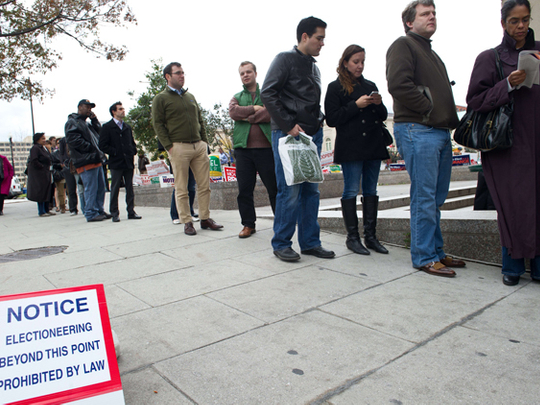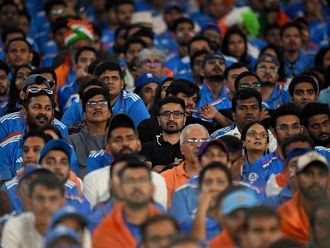
For as long as young people have played a role in the American imagination, they have been cast as figures of apathy and self-indulgence. As an actual young person, I am here to tell you that everything you think you know about young voters is wrong.
Consider, for instance, the age-old question, why don’t young people vote? It’s the one everyone wants answers to, especially as the 2020 presidential election approaches.
Here’s a hint: It’s not apathy, it’s voter suppression. That includes not just the active efforts by some Republican officials to reduce turnout by closing polling places, limiting hours and kicking people prematurely off the voter rolls, but also the specific challenges that the voting system poses for young people.
It’s likely that the 2020 election will be a tipping point for many young people who are about to lose hope in the system entirely. Many are, frankly, tired of young people’s ideas not being heard, while being simultaneously asked by older adults to be “useful” and be wholly responsible for fixing problems we didn’t create, such as by removing Donald J. Trump from office
Like many societal ills, the COVID-19 pandemic will significantly worsen this problem and at the worst possible time. Democrats (and Joe Biden in particular) could benefit significantly if young people turned out to vote in 2020 they will make up in November, in a moment when a Gen Z is beginning to fully age into the electorate.
There’s also strong evidence that young people want to turn out at the ballot box this November. The 2020 presidential election could mirror the high youth turnout of the 2018 midterm.
Highest level of youth turn over
That year, in the wake of the gun violence prevention protests and the rise of the March for Our Lives movement, there was a huge increase in voter registration that rivalled that of 2016. At the ballot box, that translated into the highest level of youth turnout in any midterm over the.
“Young people who were involved in the gun violence prevention movement were more likely to cast ballots,” Abby Kiesa, director of impact at the Center for Information & Research on Civic Learning and Engagement told me, noting that the George Floyd protests and Black Lives Matter movement could lead to a similar surge in the 2020 election.
There’s already evidence that this will happen. The Voter Participation Center saw a 250% increase in online voter registration applications in the days following the George Floyd protests. Their research also shows that Gen Z is much more interested in voting than millennials were at their age.
However, it’s possible that none of this momentum ever makes it to the ballot box. We all know that the American electoral system is unnecessarily confusing.
Young people don’t vote at lower rates than older people because they care less about the issues; they simply have less experience with our Byzantine process. The problems that typically plague young people as a result lack of information about how and where to vote, high levels of mobility, and lack of outreach from campaigns will only worsen amid the pandemic.
Take, for instance, something as fundamental as voter registration. A survey by the Center for Information & Research on Civic Learning and Engagement found that while a strong majority of young people ages 18-24 are paying attention to the 2020 election, a third of them didn’t know if they could register to vote online in their state.
As the pandemic keeps high school and college students away from campus, voter-focused organisations are scrambling to shift the voter registration help they’d been providing in person to the internet.
Gen Z registration rates
The loss of in-person services is likely to depress Gen Z registration rates, Maya Patel, a recent University of Texas at Austin graduate who now works as Texas State Coordinator for the Campus Vote Project, said in an interview.
At her alma mater, students serving as volunteer deputy registrars would register around 10,000 to 20,000 new student voters in any given election cycle through folding tables out on the quad, in-person visits to classrooms, and a voter registration party until midnight on the last day to register. Very little of that will be possible this semester as UT Austin moves many classes online to try to limit infection rates.
“It’s going to have a huge impact on voter registration, especially in states like Texas where there’s no online voter registration,” Patel said. “Students really rely on in-person guidance to help navigate the system.”
Preventing problems like these from derailing the youth vote in November will require focusing on barriers to voting as a whole and how to overcome them.
Among other things, that means enabling people to track their mail-in ballots as easily as they can track their packages, using push notifications to keep people informed on last-minute changes to polling locations, and shifting voter registration help online. However, these shortcomings also highlight the lack of infrastructure our country has to educate and sustain civic engagement among young voters.
Engaging young voters
A consistent failure to engage young voters in my generation has led us to become increasingly disillusioned with voting and the electoral system we were born in an era of gridlock and biting partisanship, and have seen protest and community-based efforts such as mutual aid networks be more effective than elections and politicians.
It’s likely that the 2020 election will be a tipping point for many young people who are about to lose hope in the system entirely.
Many are, frankly, tired of young people’s ideas not being heard, while being simultaneously asked by older adults to be “useful” and be wholly responsible for fixing problems we didn’t create, such as by removing Donald J. Trump from office.
If campaigns and politicians want young people to turn out and vote, they can’t just ask us to show up at the ballot box they need to make sure that we can get there in the first place.
As Kiesa put it, election administrators, campaigns, non-profit and even the media shouldn’t “wait until the last few months before an election to engage young people.” We want our voices to be heard, but we can’t do it alone.
Katherine Hu is a political columnist
Los Angeles Times







